Friday Mar. 14, 2008
Quiz #2 has been graded and
was returned in class. I hope to distribute grade summaries in
class after Spring Break.
How many people were in class on Friday? Somewhere around 40
people.
Scattering
of light makes the sky appear blue, makes clouds white,
and
turns the sun red at sunset.
A simple demonstration (once voted one of the prettier demonstrations
of the
semester) will, hopefully, give you a pretty good idea
what scattering
is (you'll find a picture like this on p. 107 in the photocopied class
notes).

A thin beam of bright red laser light was shined across the
front of
the classroom. Even with the lights turned off, no one in the
class could see this beam of
light. To see the beam you would need to stand over where the
beam struck the wall and look back toward the laser. The laser
light is very intense and could damage your eyes. This wouldn't
be a
very good thing to do, just as it isn't smart to look directly at the
sun.

Students in the class could see a red spot on the wall because the
light hitting the wall was scattered (a more descriptive term might be
splattered) and sent off in a
multitude of directions. A individual ray of laser light was sent
to everyone
in the class (and because the intense light is split up into so many
rays,
the individual rays are weaker and safe to look at).
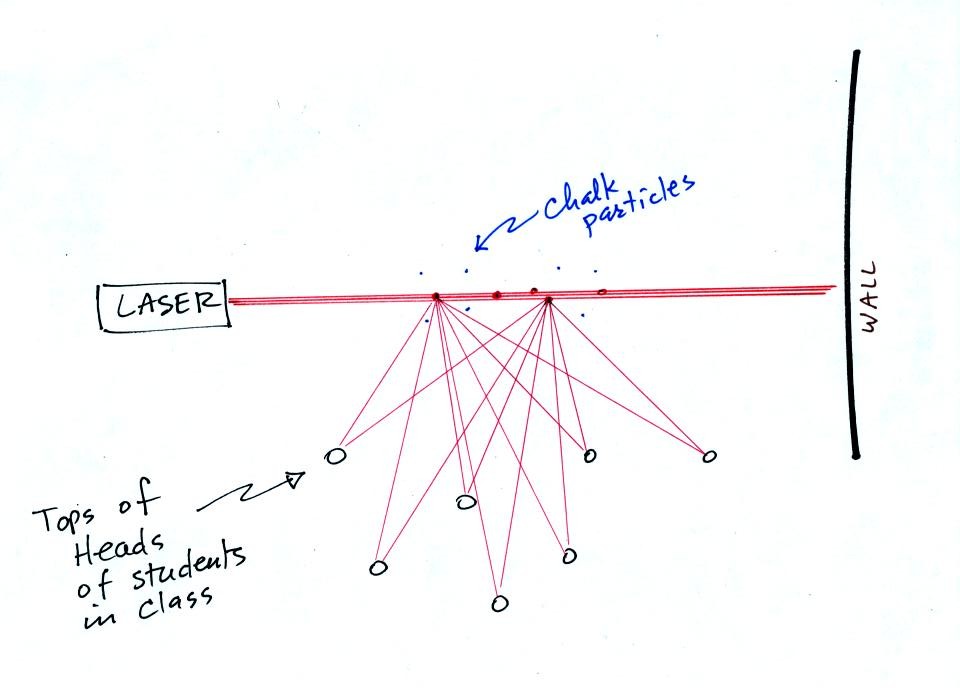
Next a couple of chalkboard erasers were clapped together. When
particles of chalk dust fell into the laser beam they intercepted some
of the laser light and scattered it. Again everyone in the room
got their own personal ray of light coming from each of the particles
of chalk. Because there were a lot of chalk particles, each
scattering light, you could see short sections of the thin laser beam.
We use chalk because it is white, it scatters rather
than absorbs visible light. What would you have seen if black
particles
of soot had been dropped into the laser beam?

In the last part of the demonstration we made a cloud by pouring some
liquid nitrogen into a cup of water. The numerous little water
droplets made very good scatterers. So much light was scattered
that the spot on the wall fluctuated in intensity (the spot dimmed when
lots of
light was being scattered, and brightened when not as much light was
scattered).
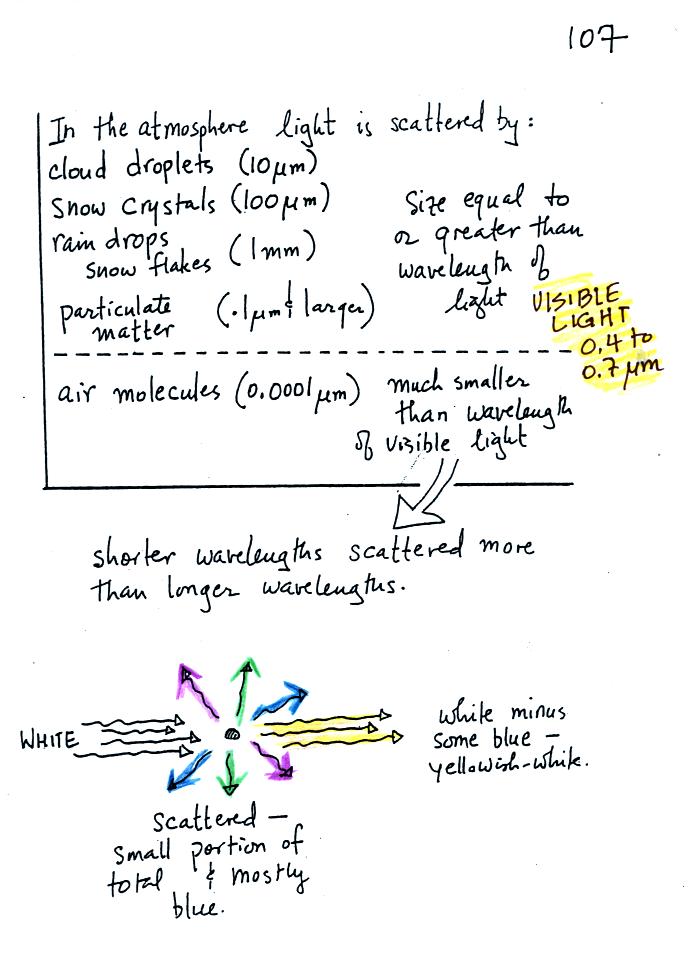
Just about everything in the atmosphere can scatter light (some
particles and gases might absorb light). These scatterers fall
into two categories: (1) those that have sizes equal to or greater than
the wavelength of the light and (2) those that are much
smaller. Air molecules fall into the 2nd group. Members of
this group scatter short wavelengths of light much more readily than
long wavelengths. We will see what effects this has.
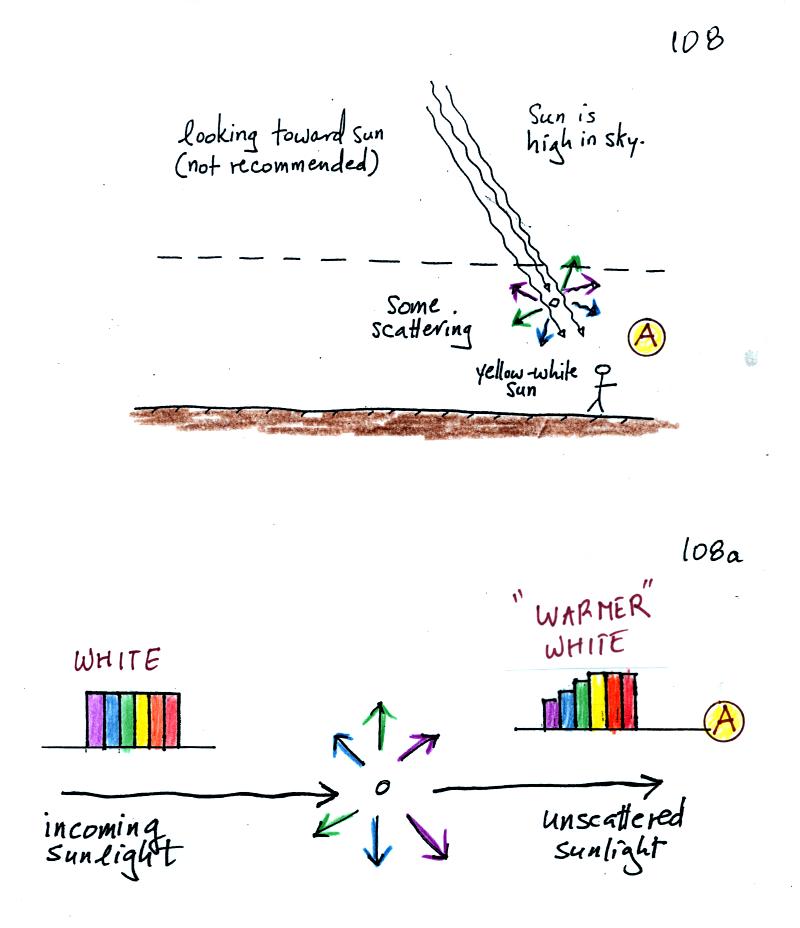
In this first figure (pieces of p. 108 and p. 108a have been put
together) we imagine going outside at midday,
turning toward
the south and looking up at the sun when it is high in the sky (you
shouldn't do this of course, sunlight is too intense and will blind
you). We assume that the sunlight arriving at the top of the
atmosphere is made up of equal amounts of all the colors. This
isn't true, but that's what we'll assume. As the sunlight passes
through the atmosphere some of the shorter wavelengths will be
scattered by air molecules. The unscattered light that makes it
to the ground will be nearly all of the original red, orange, and
yellow with a little of the green, blue, and violet light
removed. The resulting
mixture will still be very bright but will have become a warmer white
color than it was originally.
If you were to turn toward the north, away from the sun and look up at
a clear sky you would see blue light ( a really nice deep blue
following a rainstorm when the air is especially clean).
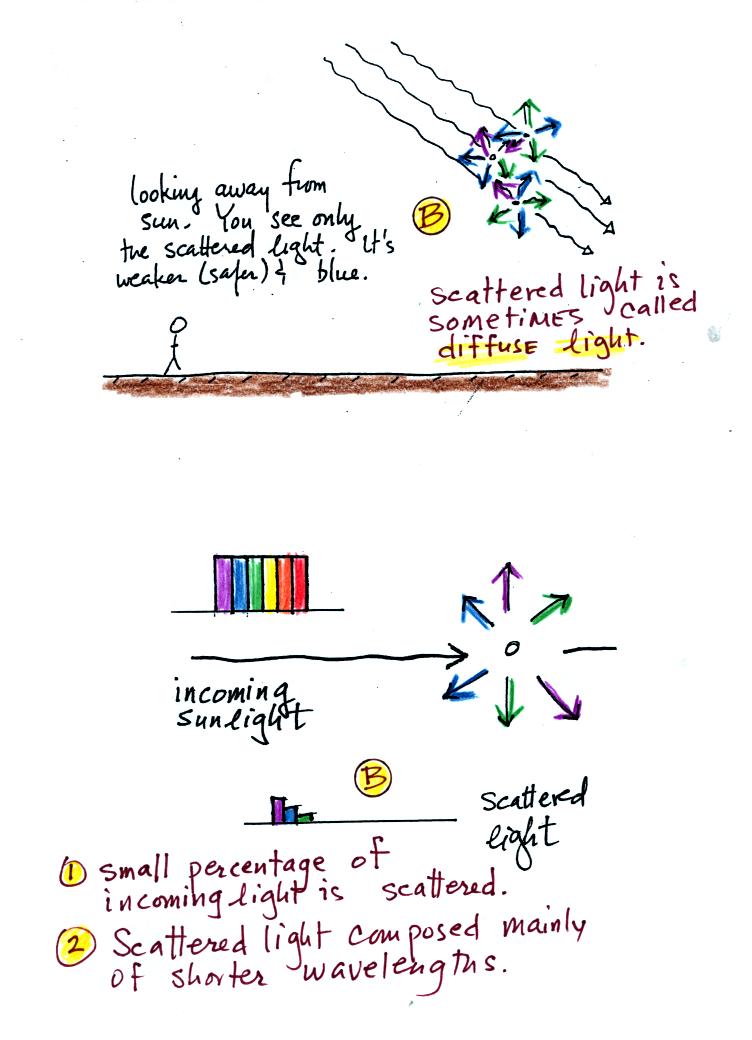
First of all you see light coming from the sky because some
of the
sunlight has been intercepted by air molecules and redirected (just
like the chalk dust and cloud droplets made the laser beam visible in
the demonstration). The sky would appear black if it weren't for
the fact that air molecules scattered light.
Two things to notice about this scattered light: first it is much
weaker than the unscattered sunlight and is safe to look at (imagine if
that weren't the case and it was dangerous to look at the sky), second
the light is blue because it is mainly the shorter wavelengths that are
being scattered.
Why is the sky blue and not green or violet? The sky isn't violet
because there isn't as much violet light in sunlight as there is green
and blue. Also our eyes might not be as sensitive to violet as
they are to blue and green. The sky probably isn't green because
that color isn't scattered as readily as the blue and violet
light. Blue is a sort of compromise.
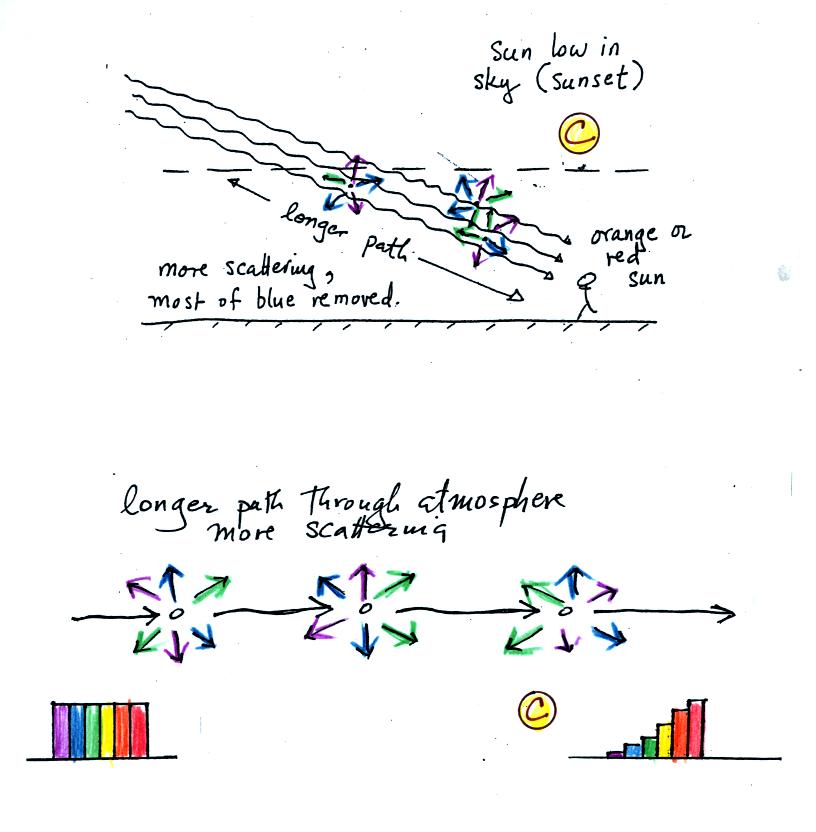
You might have noticed looking west late in the day that the
setting
sun is not as bright and is redder than it is at midday (it is still
not safe to look at the setting sun, a lot of sunlight is invisible and
we can't judge how bright it really is). The rays of sunlight
travel a
much
longer path through the atmosphere at this time of day and much more of
the sunlight is scattered. Essentially all of the shorter
wavelengths are removed from the unscattered beam of light. You
are left with a mixture of yellow, orange, and red. Sometimes
just the orange and red light are left.
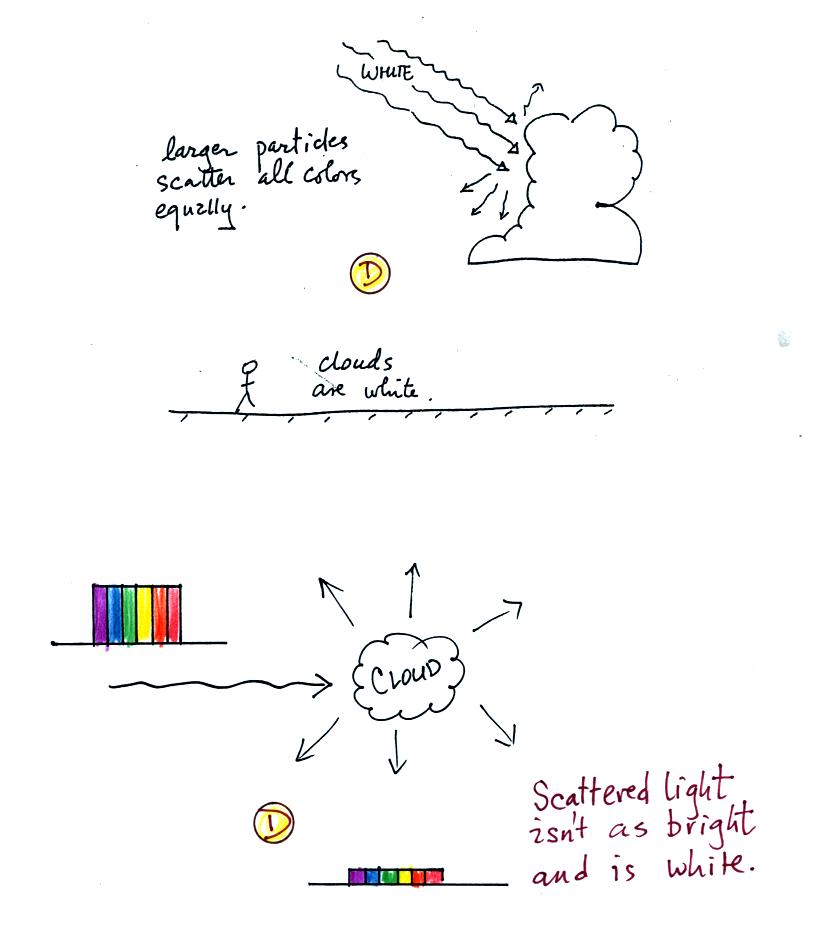
As we saw with the laser demonstration, the water droplets
in clouds
are very good scatterers of light. The cloud droplets (typically
around 10 or 20 micrometers in diameter) are larger than the wavelength
of visible light (0.4 to 0.7 micrometers). Cloud droplets scatter
all of the colors equally. When white light strikes a cloud, the
scattered light is also white (and not as bright).
Here are a
couple of more common phenomena produced by the scattering of light.
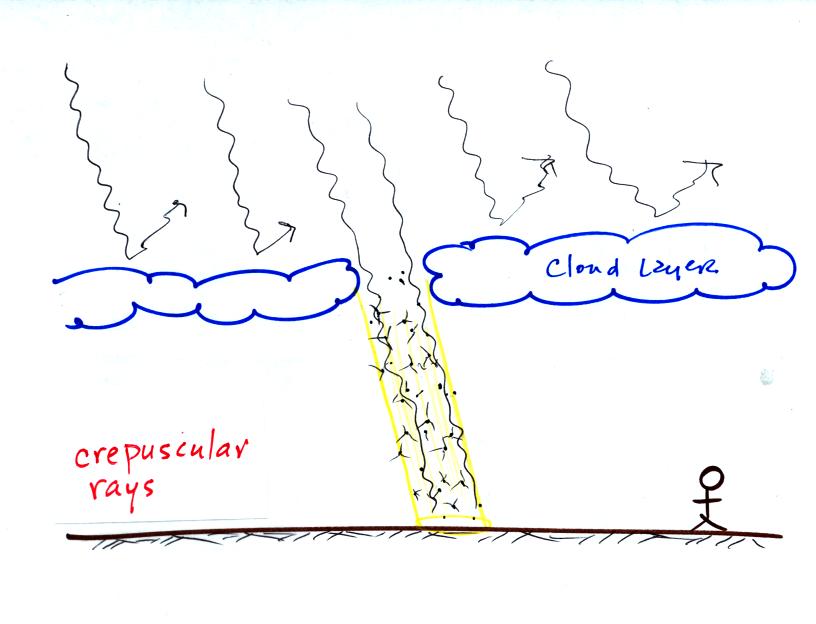
The person in this figure would see a crepuscular ray, a
shaft of
sunlight that passes through a hole in a cloud layer. The
sunlight is scattered by particles in the air. Rays of sunlight
that would ordinarily pass through the adjacent parts of the sky are
reflected by the clouds. These parts of the sky appear
darker. You'll find a nice photograph of crepuscular rays on in
Fig. 15.6 on p. 407 in the textbook.
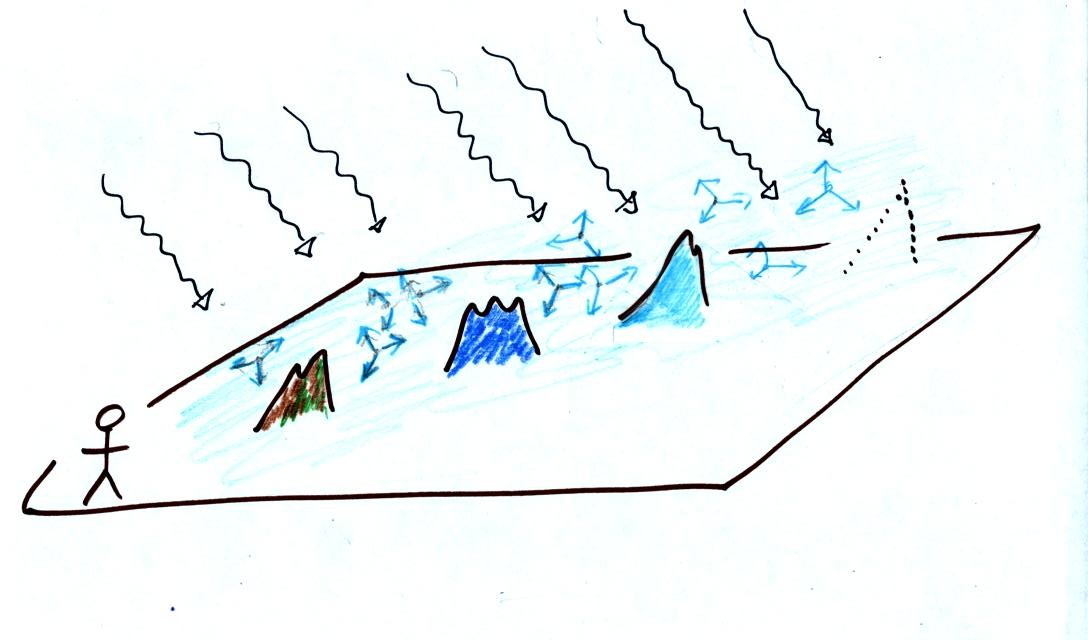
Scattering of sunlight by air molecules turns distant
mountains blue
and eventually makes them fade from view
(there is eventually much more sunlight being scattered by air than
there is sunlight being reflected by the mountains; there is a limit to
how far you can see even when the air is very clean).
A nearby mountain might appear dark green or brown. You are
mainly seeing light reflected off the mountain. As the mountain
gets further away you start seeing appreciable amounts of blue light
(sunlight scattered by air molecules in between you and the
mountain). As the mountain gets even
further the amount of this blue light from the sky increases.
Eventually the mountain gets so far away that you only see blue sky
light and none of the light reflected by the mountain itself.
You'll find a nice photograph of the changing colors of distant
mountains in Fig. 15.5 on p. 406 in the text.
The
theme for the rest of the class is "It's a great time of year."
There's something for everyone this time of year:
Spring Break, the spring equinox is next week, the NCAA basketball
tournament is about to begin, Easter is a week from Sunday.
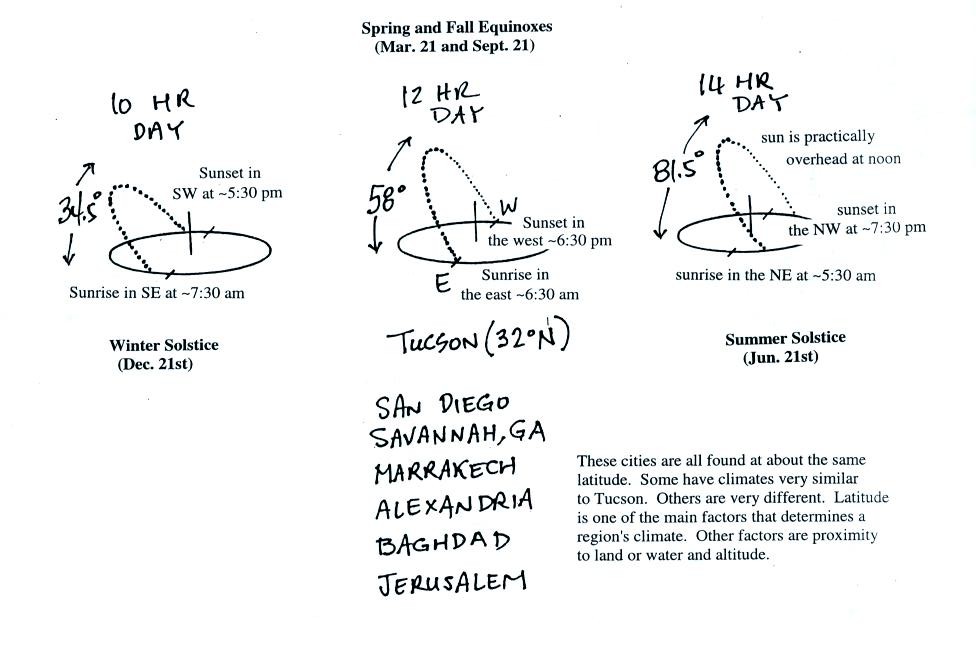
This is the front side of a handout distributed in class on
Friday. These are "sunpath diagrams." The drawings show the
path the sun follows across the sky in Tucson on the winter solstice,
the equinoxes, and the summer solstice.
One of the interesting things that happens on the equinoxes is that the
sun rises in the east and sets exactly in the west. This is shown
below.

The sun will start of the eastern horizon on the sun path
diagram and then move upward and into the southern sky.

You would need to look south and about 60 degrees above the
horizon to see the sun at noon.
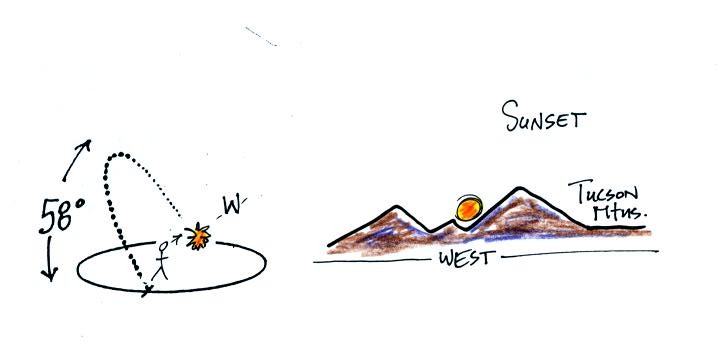
Finally the sun sets exactly in the west.
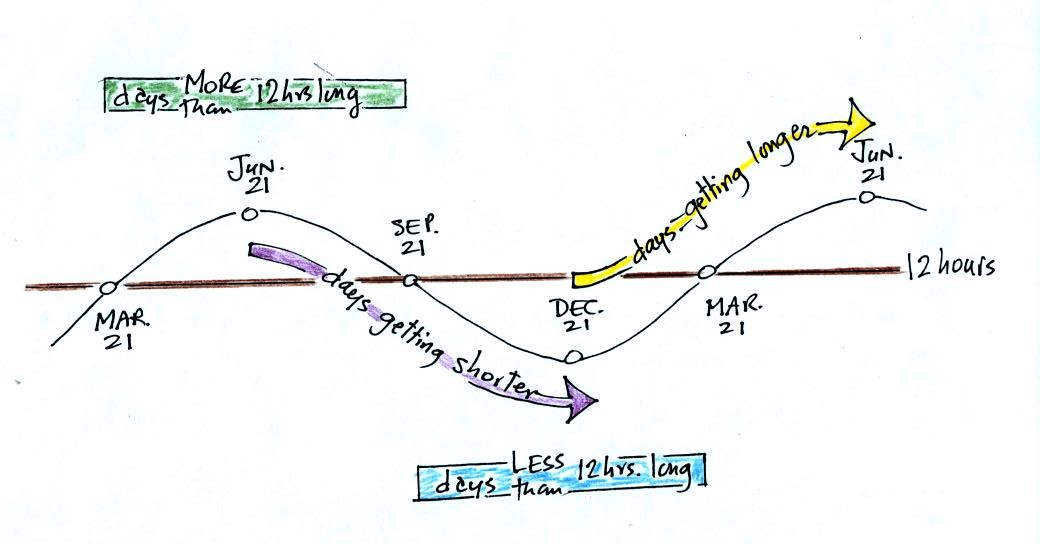
Days increase in length between Dec. 21 and June 21, then
decrease between June 21 and Dec. 21. December 21 is the shortest
day of the year, June 21 is the longest day of the year. Days are
less than 12 hours long between Sept. 21 and Mar. 21 and greater than
12 hours long between Mar 21 and Sept. 21. Days are exactly 12
hours long on the two equinoxes.
If you are driving west on Speedway at around 6:30 pm on either
the spring or the fall equinox, the sun will be shining directly in
your face. The following article is an example of what can then
happen

The accident occurred near The University at or near the equinox about
the time of sunset. The driver might really not have seen the
pedestrian in the crosswalk. You should be a little more careful
than normal when crossing east-west oriented streets early and late in
the day at this time of year.

In the summer and winter the sun
sets a little north
and south of west, respectively (the sun sets around 4:30 pm in the
winter and about 7:30 pm in the summer in Tucson).
A multiple exposure of the setting sun taken from a location on the
median on Speedway Blvd. on the fall equinox was
shown in class.

















